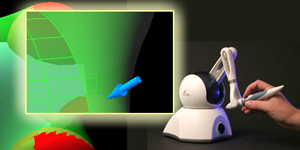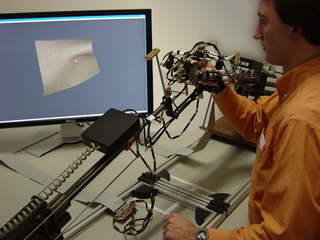Virtual Reality and Haptics
Nowadays, communication between computer and human, i.e., the exchange of information and the interaction with the machine, follows several commonly accepted paradigms. In the majority of cases, the interface between man and machine consists of screen, printer, keyboard and mouse, sometimes a scanner, head set or a graphics tablet. Most people take these tools for granted, although the work with them has to be learned and is not intuitive. The question is if there are more intuitive ways and metaphors to work and communicate with the computer. Here at the Welfenlab we research this and related questions.
One possibility for another interface design is the creation of a virtual world inside the computer that reflects our reality, which we are used to interact with. Such a virtual world or virtual reality should cosely correspond to our perception of the real world, adhering to the same natural laws and containing the same objects. In recent years, the main focus was on computer graphics and to a lesser extent on computer sounds, leading to three dimensional high resolution visualizations, that are sometimes indistinguishable from reality.
It was an early discovery that the combination of different senses in the interaction, so-called multi-modal interaction, can noticeably augment the efficiency. Due to limitations of computing power, the integration of non-visual channels, such as haptics has only just begun.
Projects
Haptex
HAPTEX - HAPtic sensing of virtual TEXtiles was a project funded by the European Union within the Sixth Framework Programme (FP6) from December 2004 to November 2007. The goal of the project was a VR system for the visual and haptic simulation of real textiles. The responsibility of our laboratory was the development of the haptic renderer. The system in use is presented in a short video clip:
Haptics, VR and CAD in the automotive industry
Haptics, VR and CAD in the automotive industry, cooperation with the Volkswagen VR Research Laboratory from 1997-2005, has led to two external dissertations of employees of the Volkswagen VR research laboratories.





